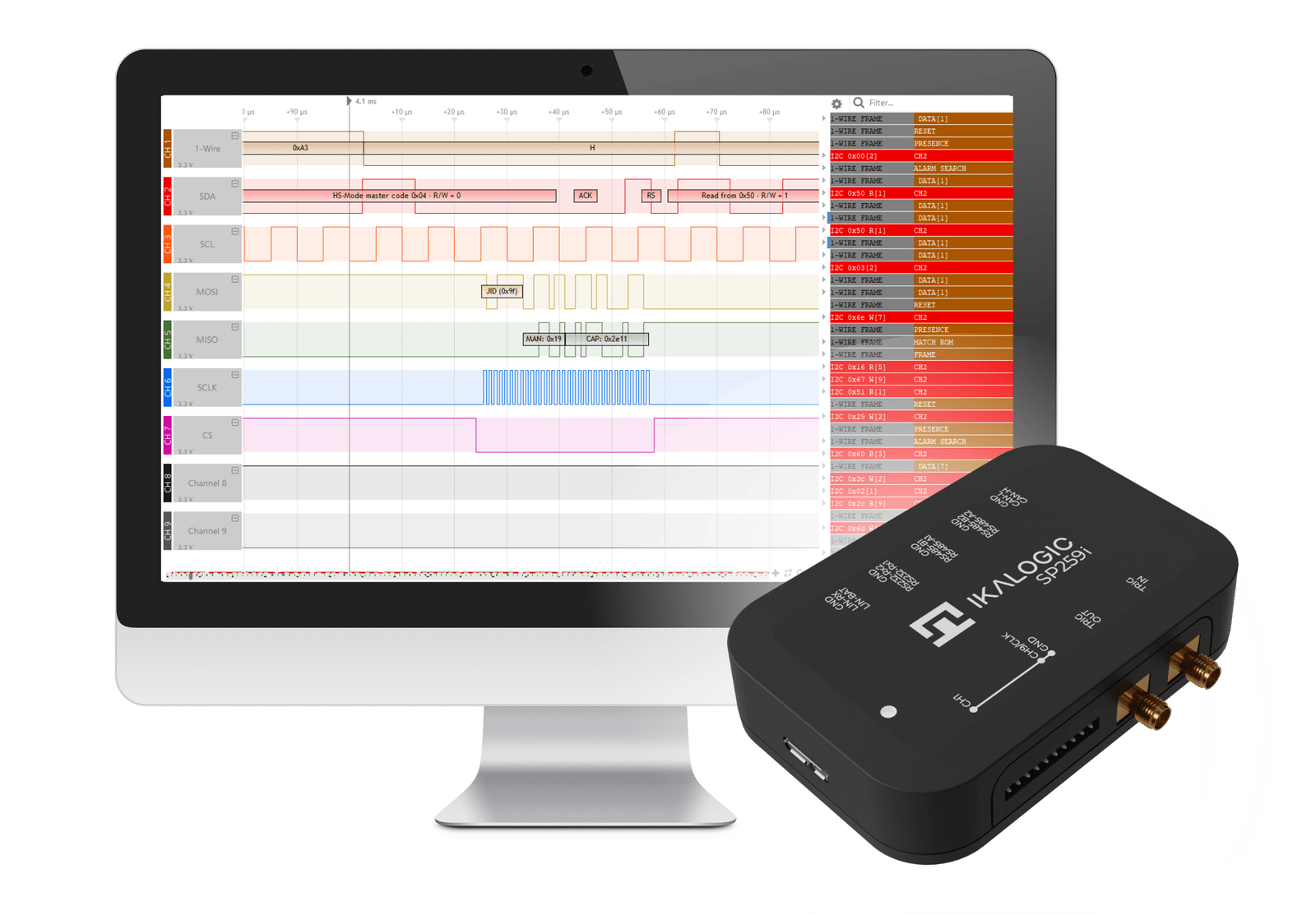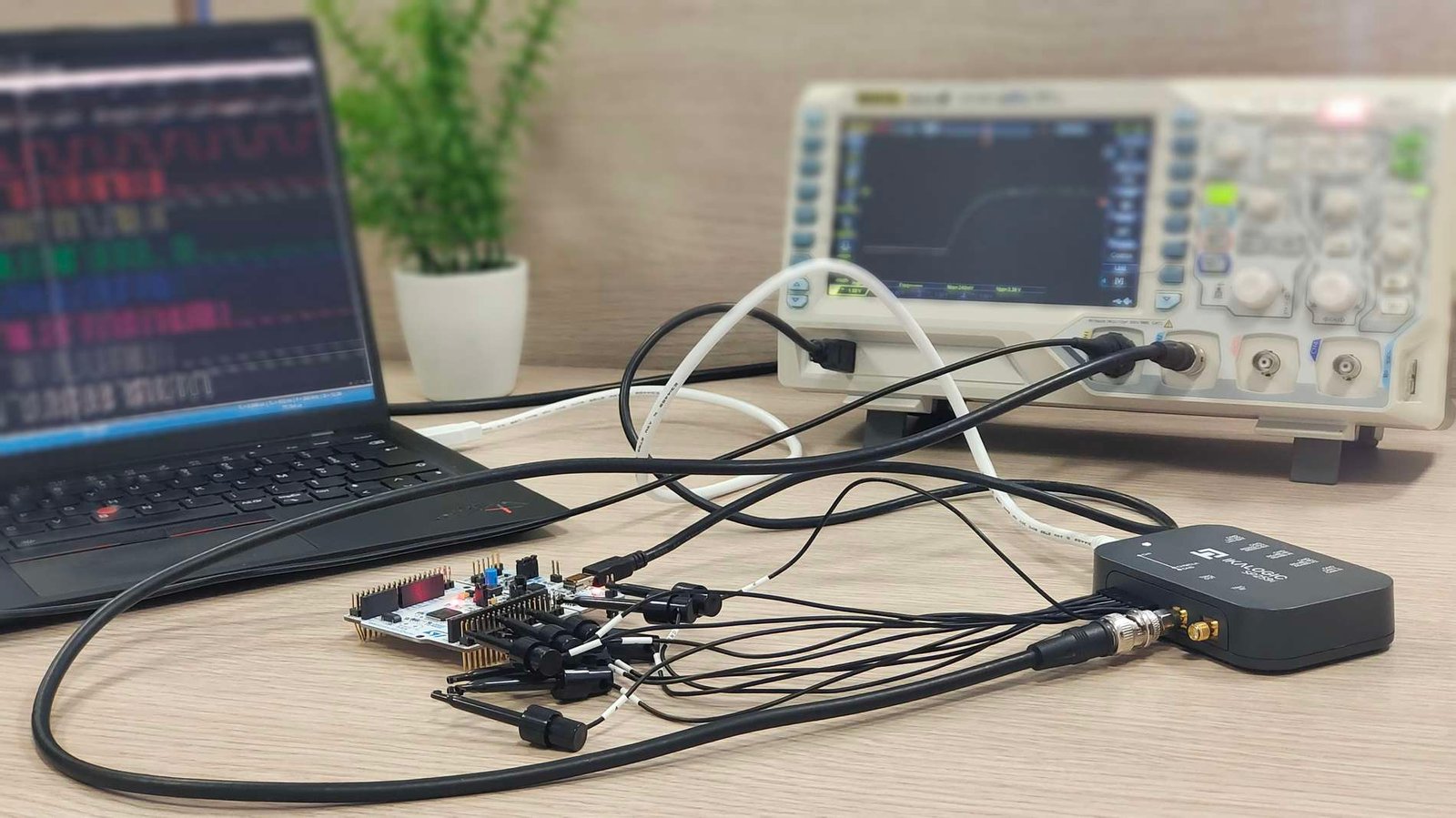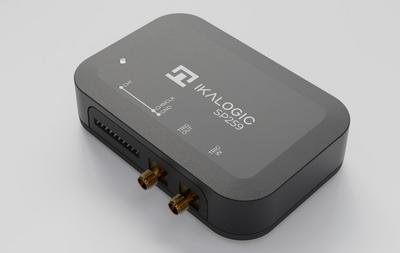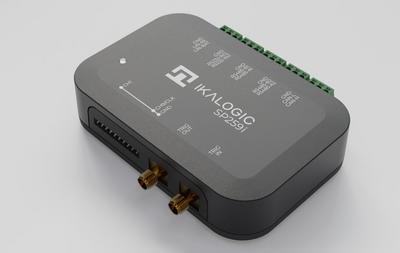SP259 logic analyzers
9 channels, 250MHz & dedicated industrial inputs
SP259 series logic analyzers and protocol decoders offer in-depth analysis of logic signals and protocols with 250MHz (4ns) timing resolution. The 9-channel logic analyzer allows 8-bit parallel data to be captured along with a clock or strobe signal. SP259 series logic analyzers rely on ScanaStudio software to capture, display, analyze and decode signals. Most industry-standard protocols can be interpreted, among which: SPI, I2C, USART, 1-Wire, CAN, LIN, I2C, RS232, RS485, TWI and many more.
- Capture & decode
- Trigger on Events
- Sync with other instruments
- Industrial ports
- Embedded memory + streaming
Connect the SP259 to your circuit and start capturing digital waveforms in seconds. Sample up to 250 MHz across 9 channels for precise timing analysis.
Instantly decode I²C, SPI, UART, 1-Wire, CAN, and more with ScanaStudio. View decoded data alongside raw waveforms for deep insight.Thanks to the scripting API and many open source examples, you can customize decoding views or write your own protocol scripts if needed.
Some logic analyzers simulate triggering in software — but the SP259 does it for real!
With a dedicated hardware trigger engine, you can reliably catch even the shortest, most elusive events. Trigger on logic changes, edges, pulse widths, protocol states, or write custom patterns using our FlexiTrig scripting engine — all evaluated in hardware, in real time.
Use Trig In to sync with external events, or Trig Out to trigger an oscilloscope at the exact moment of interest.
Easily integrate the SP259 into a multi-instrument test setup.
With support for RS232, RS485, CAN, and LIN protocols, SP259i is ideal for analyzing communication in automotive, factory automation, and embedded systems.
Easily connect to your existing wiring with standard (supplied) 3.5mm terminal blocs
SP259 streams compressed data over USB 3.0 in real time for long captures without bottlenecks.
When signal activity spikes, the internal 1Gb memory takes over, buffering samples without loss. You get the best of both worlds: the speed of streaming and the reliability of onboard memory.
SP259 Family overview
SP259 and SP259i come with a common set of features, but SP259i (industrial version) embeds industrial bus receivers to directly connect to CAN, RS232, RS485 or LIN busses.

SP259 (standard)
- 9 logic channels
- Support 1.2V up to 5.0V logic.
- 250 MHz sampling rate with 9 channels used
- 1 Gb internal buffer memory

SP259i (industrial)
- All standard SP259 features
- 2 RS232 receivers
- 2 RS485 receivers
- 1 CAN receiver
- 1 LIN receiver
Applications
- Embedded systems development and debugging — Monitor and troubleshoot digital signals during firmware development.
- Engineering education and research — Ideal for labs, teaching environments, and experimental setups.
- Serial protocol analysis — Supports I²C, SPI, UART, 1-Wire, and more.
- Industrial bus diagnostics — Analyze and troubleshoot RS232, RS485, CAN, LIN, and similar communication buses.
- Mixed-signal system validation — Capture and inspect digital outputs from ADCs and DACs.
- IoT device design — Debug and validate sensor communication and control logic in connected devices.
- Reverse engineering — Examine unknown or undocumented digital protocols and systems.
Benefits
- Capture ultra-long signal traces — Up to 2 trillion samples, ideal for in-depth debugging and protocol analysis.
- Decode and visualize signals your way — ScanaStudio lets you view data as raw bits, bytes, or high-level protocol packets.
- Zero-compromise performance — Device operates independently of USB bandwidth, ensuring full-speed data acquisition.
- Pinpoint exactly what matters — Advanced multi-stage triggering helps isolate rare or complex events with precision.
- Works seamlessly across platforms — ScanaStudio runs on Windows, macOS, and Linux.
- Free, intuitive software — No hidden costs or steep learning curves. Just plug in and start analyzing.
- Easy integration with lab instruments — Trigger IN and OUT ports enable synchronization with oscilloscopes or signal generators.
- Premium accessories included — Comes with high-quality hook-style probes for reliable connections
Frequently Asked Question
What makes the SP259 different from other logic analyzers?
The SP259 is designed for professionals who need long-duration signal capture (up to 2 Tera samples) and advanced triggering, without being bottlenecked by USB bandwidth. It also integrates seamlessly with other lab equipment via hardware triggers.
Can I measure analog signal with SP259?
No, the SP259 is a logic analyzer, specifically designed to capture and analyze digital signals. However, you can synchronize it with your benchtop oscilloscope using the Trigger IN/OUT ports. This allows you to combine digital and analog views of your system, leveraging the strengths of both instruments.
How is the SP259 powered?
The SP259 is USB-powered — no external power supply is required.
Can the SP259 handle voltages higher than 5V?
Absolutely. The SP259 is built for rugged, industrial environments and can withstand up to ±25V on all input channels. This ensures reliable operation even in case of accidental wiring errors — no external protection circuitry needed.